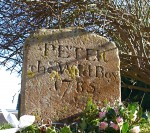 A modest headstone in the cemetery St. Mary’s Church, Northchurch, Hertfordshire, simply inscribed “Peter the Wild Boy – 1785” has been granted Grade II listing, marking it as a monument of special historic interest. The gravestone is in good condition, but it’s the man who is buried under it who makes it historically significant. Peter’s life and thus his final resting place are important witnesses to the history of disability in England, a subject English Heritage has been exploring through its listed buildings and landscapes.
A modest headstone in the cemetery St. Mary’s Church, Northchurch, Hertfordshire, simply inscribed “Peter the Wild Boy – 1785” has been granted Grade II listing, marking it as a monument of special historic interest. The gravestone is in good condition, but it’s the man who is buried under it who makes it historically significant. Peter’s life and thus his final resting place are important witnesses to the history of disability in England, a subject English Heritage has been exploring through its listed buildings and landscapes.
Peter the Wild Boy was found as a youth living a feral existence in the woods at Helpensen, about 25 miles southwest of Hanover, Germany, in May of 1724. When local farmer Jurgen Meyer found him, Peter was naked, filthy, with matted hair and long fingernails, walking on all fours and unable to speak. He had apparently been subsisting on a diet of acorns and whatever else he could forage for an unknown length of time. Small in stature, he was thought to be about 12 years old.
Meyer turned him over to the town mayor who turned him over to the St. Spiritus Poor House. Peter lived there nine months before being moved to the hospice adjacent to the prison of Celle, reportedly because he ate so much the poor house could no longer support him. There he was named Peter as he seemed to respond to the name, and it was there that Peter met the most elevated of patrons: King George I of England, who was visiting in his capacity as Elector of Hanover.
The King and the Wild Boy had dinner, which must have been an interesting study in contrasts. George left him in the care of the gardener in Hanover, but the story of the feral child returned to London with him and curiosity spread. In February 1726, Caroline, then Princess of Wales, had Peter brought to court. He became something of a pet to King George, an unwitting jester, amusing the aristocracy and nobility of England with his uncivilized antics. He liked picking the pockets of courtiers and royalty, tried to kiss fine ladies, snatched the Lord Chamberlain’s staff, wore his hat in the king’s presence, fought tooth and nail every morning when servants attempted to dress him in his elegant green suit.
 It wasn’t all fun and games. Peter was baptized and given a tutor, Scottish doctor John Arbuthnot, who tried to teach him to speak. He learned how to say his name and a garbled version of “King George,” but that was as far as he got. There’s a painting of him of the east wall of the King’s Staircase in Kensington Palace. He’s standing next to Dr. Arbuthnot on a trompe l’oeil mural that depicts King George I’s courtiers and favorites as if they were clustered on a balcony overlooking the stairs. Peter is wearing his green coat and holding oak leaves and acorns, still his favorite food, in his right hands.
It wasn’t all fun and games. Peter was baptized and given a tutor, Scottish doctor John Arbuthnot, who tried to teach him to speak. He learned how to say his name and a garbled version of “King George,” but that was as far as he got. There’s a painting of him of the east wall of the King’s Staircase in Kensington Palace. He’s standing next to Dr. Arbuthnot on a trompe l’oeil mural that depicts King George I’s courtiers and favorites as if they were clustered on a balcony overlooking the stairs. Peter is wearing his green coat and holding oak leaves and acorns, still his favorite food, in his right hands.
London society went wild over the Wild Boy. He was the subject on everyone’s lips in 1726, as a novelty and as a scientific and philosophical exhibit. To Enlightenment thinkers, Peter was a prism through which to address the question of nature vs. nurture, the “noble savage” and man’s origins in a “state of nature” before civilization permanently alters his mind and soul. Daniel Defoe called out those attitudes in a pamphlet published July 23rd, 1726, entitled Mere Nature Delineated Or a Body without a Soul.
“[Peter] seems to be the very which the learned World has for many Years past to wish for viz one that being kept entirely from Society so as never to have heard any one speak must therefore either not speak at all or if he did form any Speech himself then they should know what language Nature first form for Mankind.”
The social and intellectual reactions to an abandoned boy were prime fodder for the great satirists of the era. Jonathan Swift satirized the Peter craze in his 1726 piece It Cannot Rain But It Pours, Or, London Strewed With Rarities. Later that year, he and Dr. Arbuthnot collaborated on another satirical broadside about the lionizing of Peter, The Most Wonderful Wonder that ever appeared to the Wonder of the British Nation.
He wasn’t a boy raised by bears (seriously, in the discussion about which animal raised him, Mama Bear was one of the most popular theories) or evidence of the theoretical state of nature. From an examination of his portrait on King’s Staircase, geneticists now believe Peter suffered from Pitt-Hopkins syndrome, a chromosomal disorder characterized by drooping eyelids, prominent “Cupid’s bow” lips, coarse hair and a severe intellectual disability.
Of course, when a person is a trend, he’s going to fall out of favor soon enough. After Queen Caroline’s death in 1737, Peter was sent to live with a Mrs. Tichbourne, one of the late Queen’s bedchamber ladies, in her farm in Hertfordshire. She was paid generously to take care of him and by all accounts she was kind to him. He traveled with her on several trips to visit farmer James Fenn at Axters End in Berkhamsted, finally moving from Mrs. Tichbourne’s home to Mr. Fenn’s.
He was happy there. The government granted Peter a lifetime pension of £35 a year (paid to his caretakers) and the farmers treated him well. He liked being out in the open, helping the farmers with their work. Sometimes he wasn’t all that helpful. He liked loading manure on carts, for instance, but he liked it so much that he’d assiduously unload a full cart just to load it again. He would spend nights out of doors, looking at the stars, and would sometimes wander off impressive distances.
After James Fenn died, Peter moved in with James’ brother Thomas Fenn at Broadway Farm. His drive to go walkabout got dangerous once when he disappeared in the summer of 1751 and could not be found. Ads in the paper with offers of rewards bore no results. Months later, in October 1751, inmates were released from a Norwich jail when the building caught fire. One of the inmates was hairy and spoke in grunts and was soon identified as the missing Wild Boy. Norwich is 130 miles away from Berkhamsted. How Peter got that far, nobody knows.
He was returned to Thomas Fenn’s farm where, to avoid any future such incidents, Mr. Fenn fitted him with a leather and iron collar inscribed “Peter the Wild Man of Hanover. Whoever will bring him to Mr Fenn at Berkhamsted shall be paid for their trouble.” It’s creepy because it was padlocked in the back and looks like a dog collar or the kind of collars slaves were made to wear in Georgian England. On the other hand, it would keep him from being thrown in the slammer a hundred miles away should be wander too far afield again. That collar still exists today, in the library of Berkhamsted School
Peter would live at Broadway Farm, which passed through several hands after Thomas Fenn’s, for the rest of his life. He died on February 22nd, 1785, around the age of 72 and was buried at St. Mary’s. The grave is well-tended to and there are often flowers left on it, a symbol of the affection in which Peter’s memory is still held. A plaque inside the church reads:
To the memory of Peter, known as the Wild Boy, having been found wild in the forest of Hertswold near Hanover in the year 1725. He then appeared to be about 12 years old. In the following year he was brought to England by the order of the late Queen Caroline, and the ablest masters were provided for him. But proving himself incapable of speaking, or of receiving any instruction, a comfortable provision was made for him at a farm in this parish, where he continued to the end of his inoffensive life. He died on the 22nd of February, 1785, supposed to be aged 72.


